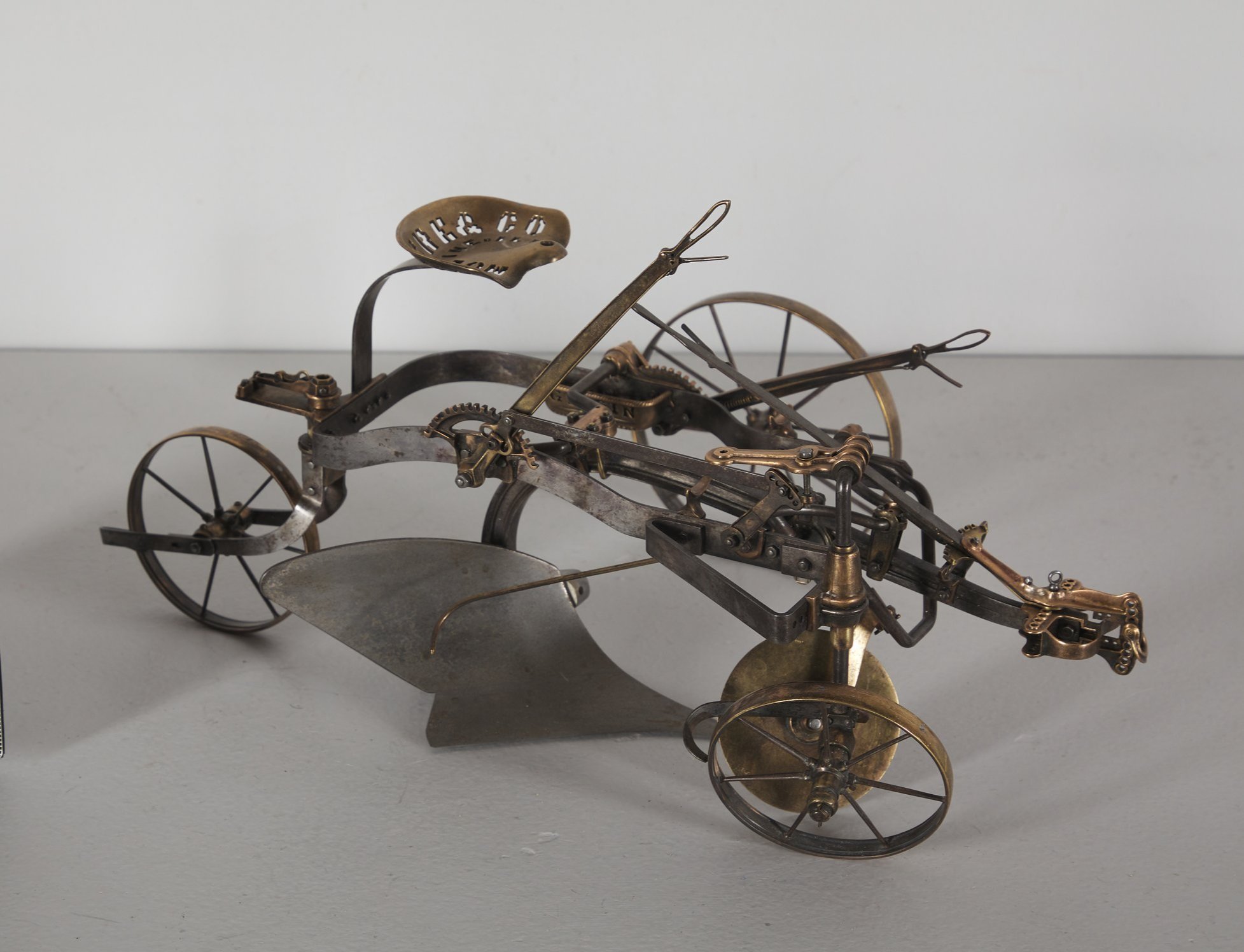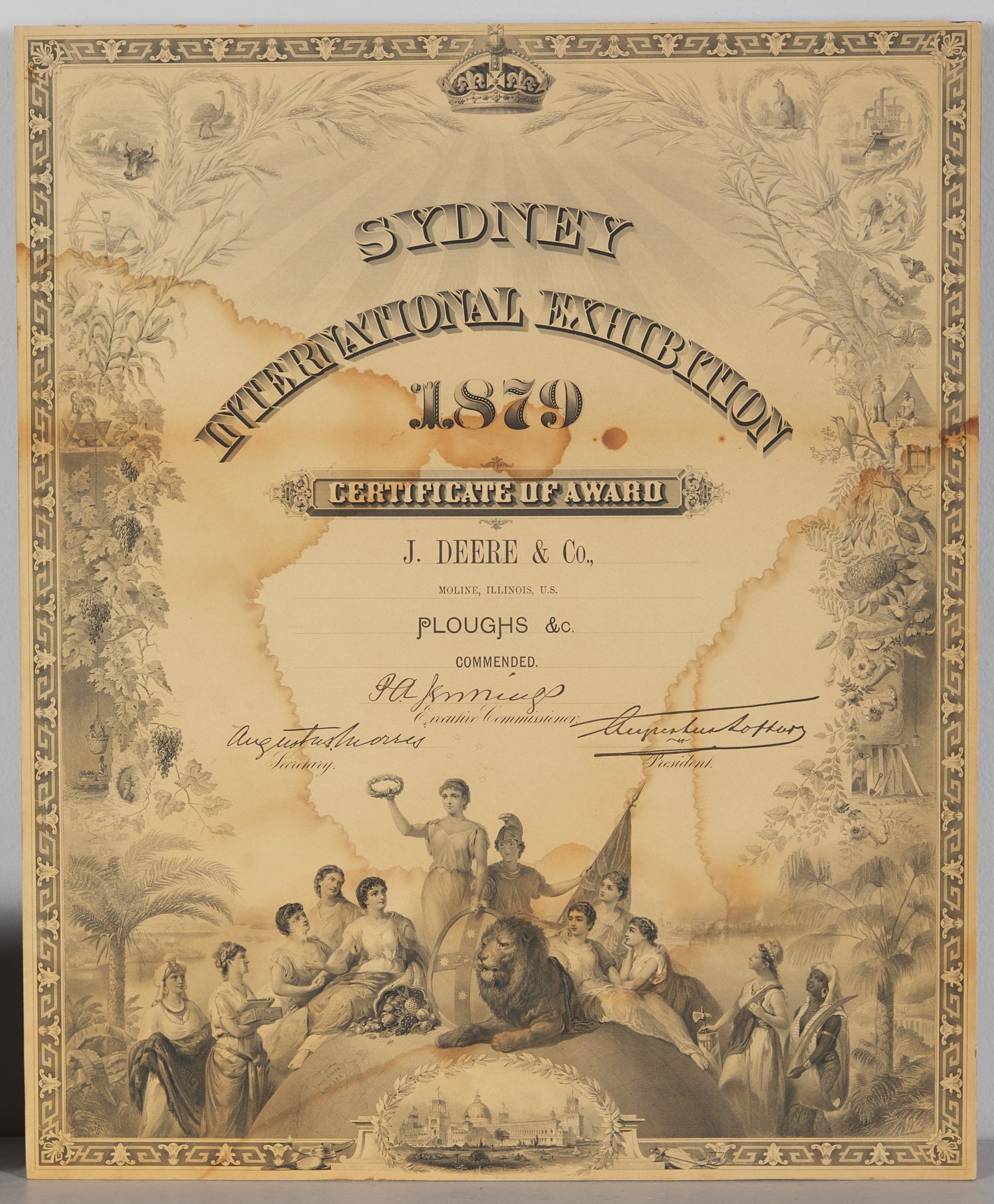Corporate archives serve as invaluable repositories of historical knowledge for organizations. Archives provide insights into the company's past, which they can leverage to inform present decision-making and future strategies. These archives serve several vital functions and are crucial in supporting various aspects of a company's operations and activities. They are sources of inspiration and are crucial in preserving corporate memory, facilitating research, ensuring compliance, and contributing to a company's overall success.
December 1904 Advertisement for John Deere (detail)
By preserving essential records and documents, corporate archives help manage risks associated with data loss, legal disputes, intellectual property protection, and continuity planning. Archives provide a backup of critical information and ensure its accessibility even during unforeseen circumstances, such as natural disasters, technological failures, or organizational changes.
Deere & Co Administrative Center in Moline, IL. The green and yellow colors of its equipment have become iconic symbols in the agriculture industry.
The goal of archive collection management is to gather, organize, preserve, and provide access to a corporation or organization's historical records and materials. Preserving corporate archives and art collections requires ongoing dedication and resources. The contents of corporate archives are often varied and require different attention; founding documents, schematics of past projects, marketing collateral, patents, products, photographs, reports, and scale models. Collaborating with professional conservators, archivists, and experts in the field can provide valuable guidance and expertise throughout the preservation process.
The John Deere Mural created in 1963 by Alexander Girard.
The John Deere Corporation, commonly known as John Deere, is an American corporation that manufactures agricultural machinery, construction equipment, diesel engines, and drivetrains. Officially incorporated in 1868, John Deere is one of the world's largest farming equipment manufacturers. The company opened its first branch office in Moline, Illinois, in 1848, and it became the company's headquarters. As the demand for its plows grew, John Deere expanded its product line to include other farming equipment such as plows, cultivators, and planters.
Detail of The John Deere mural
Detail of The John Deere mural
As the company continued to expand, so did the need for a new facility in Moline. During the construction of the Deere & Co Administrative Center that would open in 1964, Alexander Girard was commissioned to create a three-dimensional mural for the entrance space of the new building. Girard (1907-1993) was a multidisciplinary artist who worked in architecture and interior, furniture, industrial, and textile design, and the mural was to be 8 feet high by 180 feet long, created using objects from John Deere's archives. Company chairman William A Hewitt expressed his optimism for the project: "In addition to it being visually beautiful, I believe it will provide an excellent means for tying a number of suggestions of the history of our Company to the new building in which we will work."
The John Deere Mural created in 1963 by Alexander Girard.
Girard's creation is a work to behold; hundreds of objects are placed together to showcase the history of John Deere. Machinery, salesman samples, various antiques - an impressive collection of historical artifacts and memorabilia related to agriculture and machinery, including various ephemera such as photographs and advertisements. But due to the nature of many of the options - having not been created with longevity in mind - the team at The Conservation Center was brought in to assist with selecting the objects most in need of conservation.
The Conservation Center’s Transporation and Installation team de-installs elements from the mural for conservation.
The Conservation Center’s Transporation and Installation team de-installs elements from the mural for conservation.
Because of the assortment of items to be conserved, several of The Center's staff collaborated on this multi-stage project. First, in collaboration with John Deere's staff, the team determined which items were in most need of conservation. Documentary photography was taken to record the precise placement of each item in anticipation of reinstallation after treatment was complete. Dozens of items from iron machinery, mounted photographs, coins, ribbon awards, and documents were carefully de-installed and packaged into custom built storage boxes for transportation to The Center's laboratory.
The Conservation Center’s Transporation and Installation team sets up a temporary workspace to properly pack the various elements being transported to The Center’s laboratory in Chicago.
A number of metal objects needed to be cleaned of years of oxidation, dust, and grime. Select items were mechanically cleaned to treat the corrosion and were waxed to protect the surface. Other metal items were cleaned using an electrolysis process, and a combination of chemical and mechanical cleaning. Certain items, such as the sales samples, also had painted elements that required consolidation to ensure the paint was secure.
Bronze Bell, “John Deere Plow Co. #2,” before deinstallation and treatment
Bronze Bell, “John Deere Plow Co. #2,” after treatment
Painted metal Manure Spreader Model, before deinstallation and treatment.
Painted metal manure spreader model, after treatment
Painted metal Frame Wagon Model, before deinstallation and treatment.
Painted metal Frame Wagon Model, after treatment
Gang Plow Model, before deinstallation and treatment.
Gang Plow Model, after treatment.
John Deere Sprocket, before deinstallation.
John Deere Sprocket, before treatment.
John Deere Sprocket, after treatment.
Plow Model, before deinstallation and treatment.
Plow Model, after treatment.
Plow Model, before deinstallation and treatment.
Plow Model, after treatment.
John Deere Deer Emblem, 1847, before treatment.
John Deere Deer Emblem, 1847, after treatment.
Many items used in Girard's mural are paper items: advertisements, certificates, photographs, and books. Many of the originals had been mounted during the mural's creation, which dictated what treatment would be possible. The original was removed from the mounted backing when appropriate, and a digital reproduction was created. This allowed the reproduction to be displayed and for the original to be properly placed in archival storage. When the original could not be safely removed from the mount, digital reproductions were still created. In these cases, the digital reproductions ensure that the information will be retained if the original deteriorates further due to the installation methods used in 1964.
Sydney International Exhibition Certificate of Award, 1879, before treatment
Sydney International Exhibition Certificate of Award, 1879, after treatment
Sydney International Exhibition Certificate of Award, 1879, original placed into archival storage
Group Photograph, before treatment
Group Photograph, after treatment
Print of Boy Fishing, before deinstallation
Print of Boy Fishing, before treatment
Print of Boy Fishing, after treatment
Group photograph, before treatment
Group photograph, after treatment
Ledger book, mounted to board, before deinstallation
Ledger book, placed in archival storage after treatment
Badge ribbon that has become brittle with age.
Digital reproduction of badge ribbon
Badge ribbon, placed into archival storage.
Louisiana Purchase Exposition Award with Ribbon, before treatment
Louisiana Purchase Exposition Award with Ribbon, digital reproduction
Panel of ephemera before treatment
Panel of ephemera after treatment
Alexander Girard's John Deere Mural goes beyond mere decoration. It tells the story of John Deere Corporation - a creative visual telling of the company's narrative. Corporate archives are essential for preserving an organization's history, and they serve as invaluable resources for current and future generations within the organization and contribute to its long-term success. Ensuring that these many items were stable and preserved for the future required collaboration with many conservators and experts, and it was an honor to collaborate on this project with John Deere Corporation.
We are proud to share a selection of recent Corporate projects focused on the conservation and digitization of archives and other documents:
Frame by Frame: Chagall Installation We worked with the Shirley Ryan AbilityLab to treat, custom frame and install a large tapestry by Marc Chagall.
John Deere HQ: Conservation of “Reflections of an Era” by Alexander Girard. Large scale multimedia conservation project for John Deere Headquarters in Moline, Illinois.
Karl Wirsum's "Buster" Marionette in need of a Custom Mount — The Conservation Center Wirsum's "Buster," one of the artist's marionettes, is part of the corporate collection of a Chicago-based law firm. The firm's collection is focused on Chicago art and artists and is a mixed-media collection.
Time Capsule Reveal at Rush University Medical Center — The Conservation Center The Conservation Center worked with Rush University Medical Center's archivist Nathalie Wheaton to unveil the contents of several time capsules recovered on Rush's campus during an excavation in August 2016.
The Financial Lives of U.S. Presidents (and How We Conserved Them): The First National Bank of LaGrange (FNBLG)’s Presidential Checks Collection — The Conservation Center For The First National Bank of LaGrange (FNBLG)’s prized collection of Presidential Checks to be properly conserved for the first time in more than 20 years, they turned to The Conservation Center’s team for 21st century solutions.













































